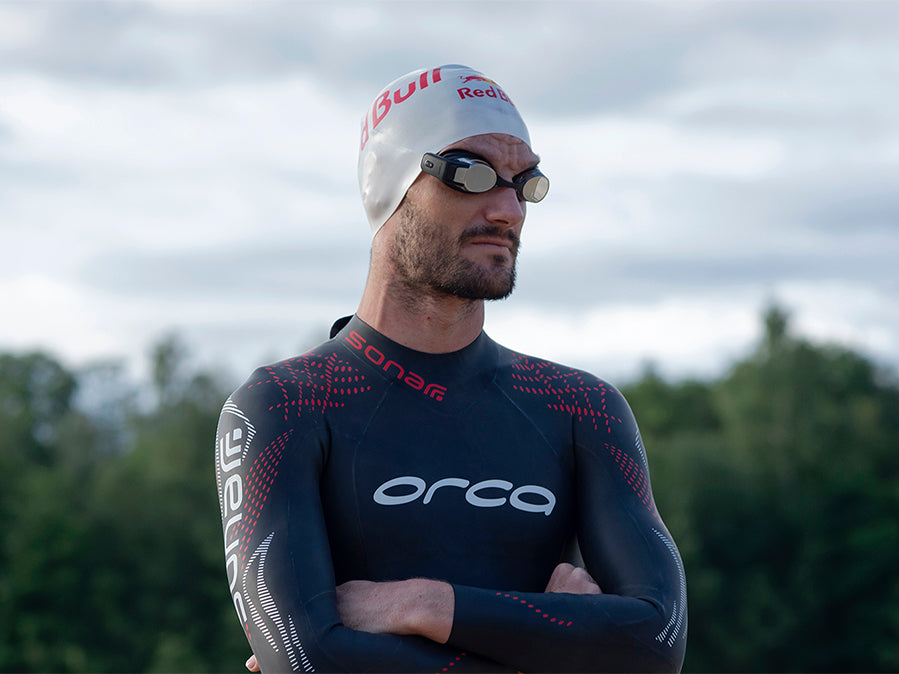A Beginner’s Guide to Triathlon Swimwear
From changing up your swim stroke to learning new breathing techniques, open water swimming for triathlons comes with a learning curve—one of which is swimwear. Between wetsuits, trisuits, swim skins, and regular competition swimsuits, it can be hard to know what you’re supposed to wear.
So, what do you wear for a triathlon? Whether you’re new to triathlon or just looking to up your gear game, it’s tough to choose the best option. We’ll go through the most popular triathlon swimwear and swimsuit options and give our recommendations for how you should suit up for race day.
Trisuit: the base layer
The trisuit is a one or two-piece suit designed to be worn for an entire race. The suit fits closely to your body to resist drag while swimming, but it’s not tight enough to cause breathing restriction during the bike and run. Trisuits usually have a few pockets to store nutrition, and they even come with a chamois pad for extra bike seat comfort.
Most triathletes will use their trisuit as a base layer. They’ll put it underneath a wetsuit or swimskin (more on those later!) Wetsuits and swimskins are then removed after the swim at the first transition.

Why not just wear the trisuit for the entirety of the race? If the water is warm enough or your swim leg is in a pool, many triathletes won’t bother with a wetsuit or swimskin. But, this comes with its pros and cons.
Pro: Triathletes can save time in the transition because they won’t have to take off a swimskin or wetsuit.
Con: They might lose a little time in the swim because the trisuit isn’t quite as hydrodynamic or buoyant as swimskins or wetsuits. It’s best to go with whatever you are most comfortable wearing while following the regulations of your race.
Wetsuit: the key to swimming quickly in cold water
If your triathlon is in North America and the swim section is in open water, chances are the water will be cold enough that the race director will allow wetsuits. While triathlon wetsuits are vital for keeping you warm in cold water, they also help you move a lot quicker than a competition swimsuit. Triathlon wetsuits consist of neoprene: a type of material that gives you buoyancy. When you are more buoyant, your hips and legs won’t sink as much, and you’ll be able to glide quicker on top of the water. Unlike a wetsuit you might wear surfing, triathlon wetsuits are flexible around the elbows and shoulders, plus they’re a lot quicker to take off. No one wants to be stuck in T1 for 15 minutes trying to peel off a bulky wetsuit.

On top of the suit’s design, wetsuits will protect your arms and legs from the sun, while the long sleeves will guard your arms against the other swimmers around you.
Because wetsuits are so beneficial to your open water swim, you should always choose to wear one if the race director allows them.
It’s also crucial that you find a wetsuit that fits you perfectly. You don’t want it so tight that it restricts breathing, but you also don’t want it so loose that it takes in water. Your best bet is to head to a local multisport store or swim store. Someone experienced in wetsuits will be able to help you out.
Swimskin: your warm water speed machine
When open water temperatures rise past a certain degree, wetsuits often aren’t allowed. This rule varies from organization to organization, but when the temperatures go over about 24.5º Celcius or 76.1º Fahrenheit, wetsuits typically won’t be permitted by the race director. Just because the water is warmer doesn’t mean your only option is a trisuit or jammers.
Enter the swimskin.
Swimskins are a newer addition to triathlons. They’re a non-buoyant, one-piece suit that fits right over your trisuit during the swim portion of your race. They sit tighter on your body, are more streamlined, and are more stable, giving you an extra edge.

Most elite and professional triathletes will use a swimskin if the water is too warm for a wetsuit, but they’re not for everybody. With the swimskin, you might gain 10-20 seconds in your swim but lose time in the transition taking it back off.
If you’re new to triathlons, swimskins aren’t a necessity, especially if you’re not planning on swimming in any warm water races. But, if you’re looking to improve your times and cut off every second possible, they could be the difference-maker.
Why not wear a competition swimsuit?
If the water is warm enough, you have every right to throw on some old jammers or a competition one piece for your swim. A jammer won’t alter your technique as much as a wetsuit or swimskin, but here are three reasons you might want to look into another option.
Chafing:
After your swim, you’ll either have to bike in your swimsuit or throw on shorts on top. Either way, your dripping swimsuit will be on for the entire race. Your swimsuit wasn’t built for biking and running, and there’s a chance it could chafe or be uncomfortable.

Swim speed:
Your bare skin isn’t as hydrodynamic as swimskins, wetsuits, or trisuits. With these apparel options, you can cover up more of your skin with material that helps you swim faster.
Transition speed:
No matter what, you can’t go directly from swimsuit to bike. Most triathlons require you to be wearing a singlet (or shirt) and shorts for the bike and run portion of your event. If you don’t want to spend time changing, it’s a good idea to wear a trisuit for the entirety of the race.
While it might seem like there are plenty of options for triathlon swimwear and swimsuits, each has its purpose. By grabbing the right gear, you'll not only move faster in the water, but you’ll also feel more comfortable throughout the race.










